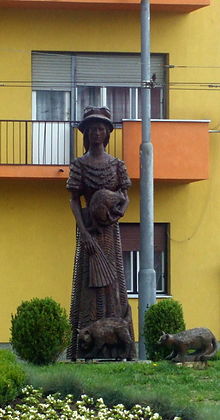Paulina Hermann
Paulina Carolina Theresia Hermann , née Lobe (born June 1, 1859 in Nova Gradiška ; † February 9, 1938 in Osijek ), was a wealthy citizen of Osijek and named after the listed Villa Mačkamama and a tram stop of the same name.
Life
Paulina Hermann was the daughter of Carl Lobe and Paulina Lobe, née Blau. She comes from a rich family, her parents owned a house, a hotel and a brewery in Nova Gradiška . She had three younger brothers: Max (1869–1933), Miroslav (1861–1938) and Richard (1874–1928). She came to Osijek between the 1880s and 1890s and stayed there for about fifty years - until the end of her life.
It is believed that she married her first husband, Dragutin Hermann (1849–1927), at the beginning of the 20th century, when she finally moved to Osijek. By marrying him she came into the wealthy Hermann family in Osijek. Her husband was a wealthy and respected citizen. In 1901 the couple became the owners of the property in the industrial district, and in 1901 Paulina Hermann became the sole owner. In 1915 she applied for her surname to be changed - presumably she was already living separately from her husband at that time. In the 1920s she gave money for the construction of altars in the Church of St. Peter and Paul in Osijek and for the monument to Bishop Josip Juraj Strossmayer . At that time she tried to sell her property in the industrial district. In 1927 she bought a large one-story house on Županijska Street, one of the most important streets in Osijek. This house bears the nickname of Paulina Hermann Mačkamama to this day .
After her husband died in 1927, she remarried in the early 1930s, this time to Baron Wessely. Gradually she got into financial crisis and conflict with her surroundings because of her lavish lifestyle. A disenfranchisement procedure was initiated.
Because of her debts, most of her property was auctioned off in 1937; her daughters Friedreika Hermann-Löibner and Angelina Hermann got the rest. She died after a long illness in her house on Županijska Street.
Legend
While the name “Mačkamama” is well known in Osijek, not much is known about Paulina Hermann.
Most of the information about her character comes from the city's older residents who can still remember her. They describe her as an eccentric and wealthy woman who threw parties in her home and went bankrupt because of her lavish lifestyle and especially her love for pets. It is precisely because of this love for pets that she is best known - which is why she was nicknamed "mother cat". She actually owned large numbers of cats, but she also had dogs, pigeons, and other animals. Among them was a lion that she tried in vain to sell to pay her tax debts. Allegedly, she also buried her pets; skeletons of cats are said to have been found during the construction of the kindergarten in the 1970s.
There is speculation that she was deranged. The fact is that her home had to be disinfected and that she withdrew from the public eye towards the end of her life. What is less known is that she was also viewed as an intelligent woman who was always helpful. After her death, the newspaper “Slavonski List” wrote that she always kept the doors of her castle open for the poor and that homeless people could stay there for free. Apparently no poor person left her empty-handed.
The history that surrounds the “mother cat”, together with the authenticity of the building, contributed to the fact that the castle was registered as a cultural monument.
monument
On December 2, 2006, a new tram line was introduced in the city of Osijek in the direction of the industrial area. The first stop was named "Mačkamama" after the legend of Paulina Hermann. At the same time, her monument, which is located in the middle of the Wendeschleife, was unveiled. The statue made of Slavonian oak was made from an old photograph by Paulina Hermann. The statue shows her with a characteristic hat on her head, a fan in one hand and a cat in the other. In addition, 10 more cats were planned to surround them, currently there are four. The authors of the project are members of the Ernestinover Colony, whose most famous member Mato Tijardović is also a resident of the industrial district.
literature
- Božica Valenčić: Vila Pauline Hermann - Dvorac “Mačkamame” u Osijeku,
- Muzej Slavonije Osijek: Osječki zbornik XXI, 1991
Web links
- Image of the monument
- Vjesnik on-line (October 25, 2007)
- Obilježen Dan grada Osijeka- najveselije u Bosutskom naselju (October 27, 2007)
- Osijek Online (October 27, 2007)
| personal data | |
|---|---|
| SURNAME | Hermann, Paulina |
| ALTERNATIVE NAMES | Hermann, Paulina Carolina Theresia; Lobe, Pauline (maiden name) |
| BRIEF DESCRIPTION | wealthy citizen of Osijek, namesake of the listed Villa Mačkamama and a tram stop of the same name |
| DATE OF BIRTH | June 1, 1859 |
| PLACE OF BIRTH | Nova Gradiška |
| DATE OF DEATH | February 9, 1938 |
| Place of death | Osijek |
